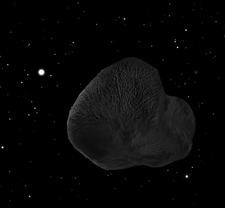Discovery date 2003 Eccentricity 0.4316 Mean radius ~1.5 km Orbital period 1.3 years Orbital period 1.3 years | Mean orbit radius 17.145 Gm Discovered 2003 Orbital period 459 days | |
 | ||
Discoverers John J. Kavelaars, Brett J. Gladman, Scott S. Sheppard, Jan Kleyna, David C. Jewitt Similar Scott S Sheppard discoveries, Jupiter moons, Other celestial objects | ||
Carpo (/ˈkɑːrpoʊ/ KAR-poh; Greek: Καρπώ), also Jupiter XLVI, is a natural satellite of Jupiter. It was discovered by a team of astronomers from the University of Hawaii led by Scott S. Sheppard in 2003, and was provisionally designated as S/2003 J 20 until it received its name in early 2005.
Carpo is about 3 kilometres (1.9 miles) in diameter, and orbits Jupiter at an average distance of 17.145 Gm (just over ten million miles) in 458.625 days, at an inclination of 56° to the ecliptic (55° to Jupiter's equator), and with a high eccentricity of 0.4316. All of the moons further from Jupiter than Carpo are retrograde.
It was named in March 2005 after Carpo, one of the Horae, and a daughter of Zeus (Jupiter).
Like Themisto, this moon seems to be the lone member of a unique class, which makes it particularly interesting. The orbital inclination of satellites such as this one is limited by the Kozai effect, discovered by Yoshihide Kozai in 1962. This effect induces a periodic exchange between the inclination and eccentricity of the orbit; if the inclination is large enough, the eccentricity can in turn grow so large that the periapsis of the satellite (called the perizene in the case of moons of Jupiter) would be in the immediate vicinity of the Galilean moons (Io, Europa, Ganymede and Callisto). The satellite would eventually collide with one of these, or a close encounter would eject it altogether from the Jovian system. The periapsis precession period (Pw) is 6.8 million years long.
